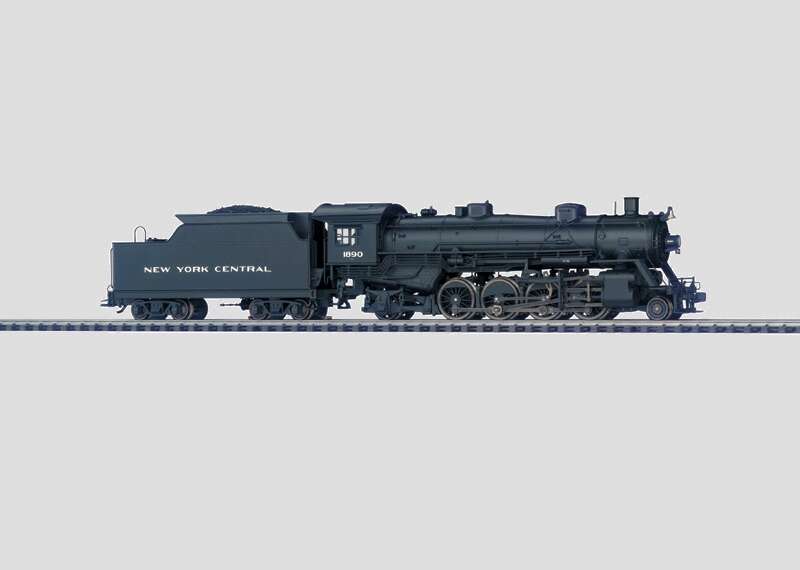Märklin, New York Central damplok type Mikado, med C90 lyddekoder med damplyd, fløyte og klokke, lengde 29 cm, epoke II og III.
Røykagregat 72270 kan monteres. Engangserie 2003
Prototype: New York Central Railroad (NYC) class H 6 general purpose locomotive. United States Railroad Association (USRA) standard design 2-8-2 "Mikado".
Model: Locomotive comes with a digital decoder, controlled highefficiency propulsion, and sound effects generator. High-efficiency motor with bell-shaped armature in the boiler. 4 axles powered. 2 traction tires. Locomotive can be retrofitted with 72270 smoke generator. Headlights and smoke generator contact will work in conventional operation and can be controlled digitally. Headlights are maintenance-free LED's. Synchronized steam locomotive sound effects that vary with the locomotive's speed, whistle as well as a bell sound or acceleration and braking delay can be controlled digitally with the 6021 Control Unit. Prototypical nonworking coupler plugged in on the front. Close coupling between locomotive and tender. Separately applied metal handrails. Many separately applied details. Figures of a locomotive engineer and fireman for the engineer's cab are included. Length over couplers 29.0 cm / 11-7/16*.
Highlights:
- Metal locomotive frame, boiler, and tender floor and body.
- High-efficiency motor with bell-shaped armature in the boiler.
- Sound effects: Cylinder/exhaust
- synchronized, whistle, and bell.
- Can be used on track with a minimum radius of 360 mm / 14-3/16*.
One-time series
Mikado Every successful sports team has its stars in the headlines. But, it also has those players in the background that it cannot do without. So it is with the Mikado steam locomotive. Neither high stepping passenger locomotive, nor massive freight locomotive, the "Mike" still stood tirelessly at the center of the competition among American railroads. The first 2-8-2 came out of the Baldwin Locomotive Works in 1890, built for a narrow gauge railroad in Mexico. This wheel arrangement was the latest in a long series of locomotive development. The first major order for the 2-8-2 locomotive was made by the Nippon Railway of Japan in 1897. A Gilbert & Sullivan opera of that era would give this locomotive its name, Mikado. As with most other railroad developments, adoption of the 2-8-2 wheel arrangement was a slow process. The 2-8-2"s trailing truck allowed for a larger firebox, which offered an incremental increase in power and also allowed the Mikado to operate at higher speeds due to its better tracking. This would make the "Mike" a powerful addition to many railroads" freight locomotive rosters. Always conservative and saving, American railroad management continued to hold on to the 2-8-0 locomotive for a long time. This would abruptly change in 1917. In Europe, the War to End All Wars was being fought, and it became increasingly apparent that the United States would become involved in the conflict. Yet, the railroads of the United States were unprepared for such an event. Terminal delays and faltering locomotives made it necessary for President Woodrow Wilson to intervene. With the founding of the United States Railroad Administration (USRA), the federal government took over operation of the privately owned railroads. The war ended in 1918, but the USRA continued for another two years before operations were finally returned to private hands. Whether government operation of the railroads was successful or not, one clear benefit from this operation was the legacy of a set of standardized locomotive designs. These engines ranged from 0-6-0 and 0-8-0 switching locomotives to 4-6-2 passenger locomotives to heavy 2-8-8-2 freight locomotives. These designs proved to be efficient and powerful. With the close of the USRA chapter, these standard locomotives were returned to the private railroads. As further proof of the strength of these designs, more post-war copies of the USRA locomotives were built than were originally built during the war. There are strong parallels between the USRA designs and the german "Einheitslokomotiven". The USRA Mikado is quite similar to the DRG Class 41; the USRA light Pacific is very similar to the Class 03. In contrast to the ongoing standardization in Germany, the railroads of the United States reverted to their old ways, taking a standard design and modifying it to reflect their particular needs and requirements. The US railroads would have to learn the lessons of standardization again in two decades from a German invention. With the diesel locomotive, American railroading would finally use standard locomotive designs. The Märklin model is based on an original USRA design of the "Light Mikado". It reflects the appearance of the locomotive in later years of operation on the New York Central Railroad, which had the greatest number of Mikados in North America, with many variations. The Mikado remained in service well into the 1950"s, when dieselization finally made the departure of the steam locomotive complete.
- Forside
- Nye produkter
- Figurer
- Trix
- Roco
- Fleischmann
- Lux Modellbau
- Piko, SALG!!
- Viessmann
- Lenz Digital
- Uhlenbrock
- Scalextric SALG!!
- HO byggedeler
- HO vognlast
- Byggematerialer
- Maling & lim
- Båter, SALG!
- Modellbiler, SALG!
- Byggesett
- Kibri
- Heljan, SALG!
- Arnold, SALG!
- Auhagen
- Pola, SALG!
- Vollmer
- Faller
- Brawa
- Heki
- Woodland, SALG!
- Hobby Verktøy



